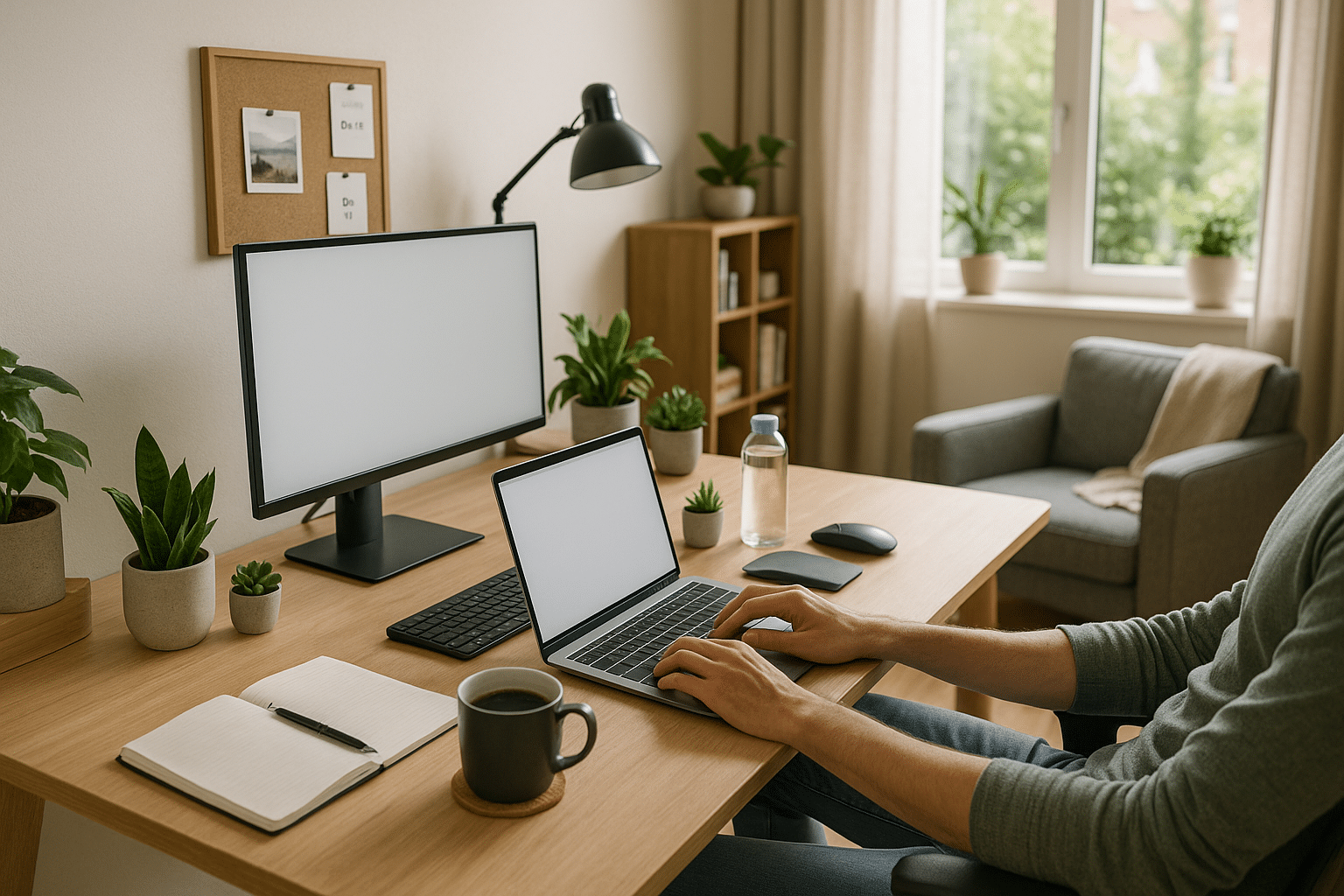Welcome to the world of remote work, a world where the phrase “the world is your office” can be taken literally! The freedom to work from any location – be it a bustling café in Paris, a serene beach in Bali, or the cozy comfort of your own home – is a reality for many professionals today. But as alluring as this reality sounds, it comes with its unique set of challenges. Designing your perfect workspace, setting up a productive routine, and maintaining a healthy work-life balance – these are just a few of the many aspects you need to master in this new mode of working. In this article, we’ll delve into the art of crafting the perfect remote workday.
😊
Let’s set the stage by acknowledging that remote work is not a temporary trend; it’s here to stay. Statistics have shown a significant increase in the number of remote workers over the past decade, and this rise is expected to continue in the coming years. It’s a transformative shift in the way we work, spurred by advancements in technology and a global effort to create more flexible and inclusive work environments.
However, a successful remote workday is not just about having a good internet connection and a laptop. It requires planning, discipline, and the right tools. So, how can you ensure that your work from home experience is as productive and fulfilling as possible? This article aims to answer that question.
👩💻
Designing Your Ideal Workspace
Working from home does not mean working from bed. While it might be tempting to stay in your pajamas all day and work from the comfort of your blankets, it’s not a recipe for productivity. You need a designated workspace – a place that signals to your brain that it’s time to switch into ‘work mode’.
In this section, we will discuss how to set up your ideal workspace. We’ll look into aspects such as choosing the right furniture, optimizing your space for productivity, managing noise and distractions, and more. We will also delve into the importance of ergonomic design and how it can impact your health and efficiency.
Setting Up a Productive Routine
Now that you have your workspace set up, let’s talk about routines. A solid routine can be a game-changer when it comes to remote work. It helps you stay organized, manage your time effectively, and maintain a healthy work-life balance.
In this section, we’ll explore tips for setting up a routine that works for you. We’ll cover everything from managing your to-do list, time blocking techniques, taking breaks, staying motivated, to winding down after a productive day. These strategies can help you craft a routine that is tailored to your working style and personal needs.
🏡
Combining Workspace and Routine
Finally, we’ll tie everything together by discussing how your workspace and routine can work together to create a harmonious and productive remote workday. Because at the end of the day, a great workspace and a solid routine are two sides of the same coin – both are essential for a successful remote work experience.
So, whether you’re a seasoned remote worker looking for ways to optimize your workday or you’re just starting your remote work journey, this article has something for you. Let’s embark on this journey towards crafting the perfect remote workday!
Architecting the Ultimate Remote Workspace
Creating a productive and ergonomic workspace is crucial for every remote worker. This space is not just an area to perform your duties, but also an environment that can stimulate creativity, boost productivity and promote overall wellbeing. Let’s dive deep into the technicalities of designing an ideal workspace.
First and foremost, the selection of a location is pivotal. Choose a spot with ample natural light and minimal distractions. Avoid places with a lot of foot traffic or noise, as it can hinder your concentration. A good practice is to separate your workspace from your leisure areas, fostering a physical and mental boundary between work and relaxation. This distinction aids in achieving a healthy work-life balance.
Consider investing in ergonomic furniture, such as an adjustable chair and desk. These investments can support good posture, thereby reducing the risk of musculoskeletal issues. Ergonomic keyboards and mice are also worth considering to prevent carpal tunnel syndrome. Additionally, a second monitor can prove beneficial in multitasking and reducing the need for window switching. To illustrate the difference between a standard and ergonomic setup, see the table below.
| Standard Setup | Ergonomic Setup |
| Regular office chair | Adjustable chair with lumbar support |
| Fixed height desk | Adjustable height desk |
| Standard keyboard and mouse | Ergonomic keyboard and mouse |
| Single monitor | Dual monitors |
Designing a Productive Daily Routine
Having a well-structured daily routine is as important as having an ideal workspace. It gives your day a structure and ensures you are maximising your productivity without compromising your wellbeing. Here are some tips for crafting your perfect workday routine.
Begin by defining your most productive hours. Everyone has a unique internal clock, known as a circadian rhythm, which dictates their energy levels throughout the day. Some people are more productive in the morning, while others find their peak productivity in the afternoon or evening. Identify your peak hours and schedule your most challenging tasks for these times. For a visual understanding of how circadian rhythm influences your day, watch this video: “The Science of Circadian Rhythms” by the YouTube channel Seeker.
Next, make sure to include regular breaks in your schedule. The Pomodoro Technique, which involves working for 25 minutes followed by a 5-minute break, is an excellent method for maintaining focus and preventing burnout. Also, don’t forget to schedule time for lunch and a few short breaks to stretch your legs or get some fresh air.
Maintaining Work-Life Balance
Remote work can blur the lines between personal life and work. Therefore, it is crucial to establish boundaries to maintain a healthy work-life balance. Here are some strategies to consider.
Establish a clear start and end to your workday. Just because you are working from home does not mean you should be working all the time. Define your work hours and stick to them. After your workday ends, resist the urge to check emails or perform any work-related tasks.
Next, ensure you have time for relaxation and recreation. Take up a hobby, read a book, exercise, or engage in any activity that you enjoy. This “me” time is crucial for recharging your batteries and maintaining mental health. If you are struggling with setting boundaries, watch this insightful video: “5 Tips for Healthy Work-Life Balance” by the YouTube channel Mindful Ambition.
- Set clear boundaries between work and personal life.
- Take regular breaks throughout the day.
- Schedule “me” time for relaxation and recreation.
- Stick to your defined work hours.
In conclusion, creating the perfect remote workday involves designing an ergonomic workspace, crafting a productive daily routine, and maintaining a healthy work-life balance. Each aspect is critical and contributes to your overall productivity and wellbeing. The journey to the perfect workday is unique to each individual, and what works for one person may not work for another. Therefore, experiment with different setups and routines, and find what works best for you.

Conclusion
In conclusion, we’ve journeyed through a broad spectrum of topics central to the world of Software Engineering and Information Technology. From the fundamental principles of these fields, the inherent challenges, to the innovative solutions, we’ve delved into the intricacies that form the backbone of our digital world.
To recapitulate, we started by exploring the foundational principles of Software Engineering, such as the software development lifecycle, coding standards, and testing methodologies. This deep dive provided us with a robust understanding of how software systems are conceived, designed, implemented, and maintained. 🔄
We then examined the ever-evolving landscape of Information Technology, touching on topics like cloud computing, data analytics, cybersecurity, and artificial intelligence. These areas are transforming the ways we live and work, making our lives more convenient, businesses more efficient, and societies more interconnected than ever before. 🌐
However, it’s important to remember that these advancements come with their own set of challenges. We discussed topics such as security concerns, data privacy, ethical considerations, and the digital divide. As professionals in this field, it’s crucial for us to be cognizant of these issues and strive to mitigate them. 🔒
Nevertheless, the potential benefits of these technologies far outweigh the challenges. Hence, we highlighted the innovative solutions, the cutting-edge technologies and the inspiring individuals who are driving the progress in these fields. We took a look at the trends shaping the future of Software Engineering and Information Technology, and how we can leverage these trends for a better tomorrow. 💡
So, what can we take away from all this? It’s clear that Software Engineering and Information Technology are fields of immense potential, continuously evolving, and full of opportunities for those willing to engage and innovate. They are not just about coding or managing systems; they are about envisioning and creating the future. 🚀
Therefore, I encourage you to dive deeper, explore these fields, and apply what you’ve learned. Whether you’re a seasoned professional, a budding enthusiast, or someone simply curious about these topics, there’s always something new to learn, something interesting to discover.
Feel free to comment below, share your thoughts, or ask any questions. Let’s engage in a discussion and learn from each other. And do share this article with anyone you think might find it useful. Your engagement can make a huge difference.
For further reading, you can refer to a plethora of resources available online. Websites like W3Schools and Mozilla Developer Network offer in-depth tutorials and guides. Online platforms like Coursera and Udemy provide comprehensive courses covering a wide range of topics.
To sum up, as we stand at the cusp of the Fourth Industrial Revolution, let’s strive to harness the power of Software Engineering and Information Technology for the betterment of our world. Together, we can make a difference. Let’s build a brighter, more connected, and inclusive digital future. 💪🌐🚀
Remember, the future is not something that just happens. It’s something we create. So, let’s get creating!
Sources:
– IBM
– Microsoft
– Google
– Oracle



